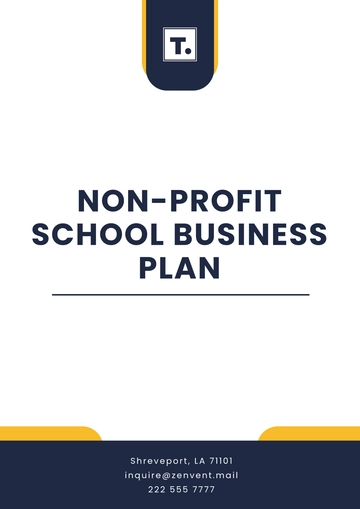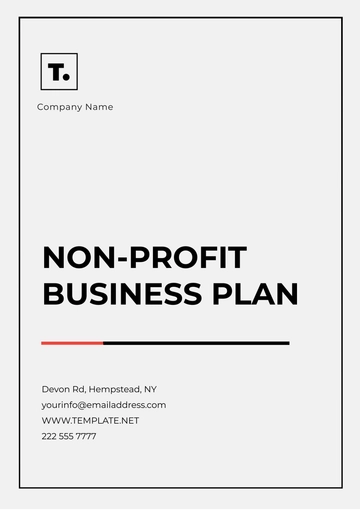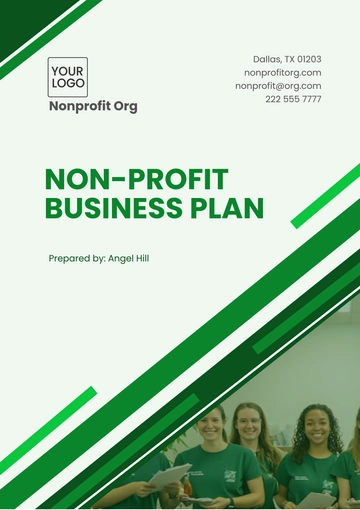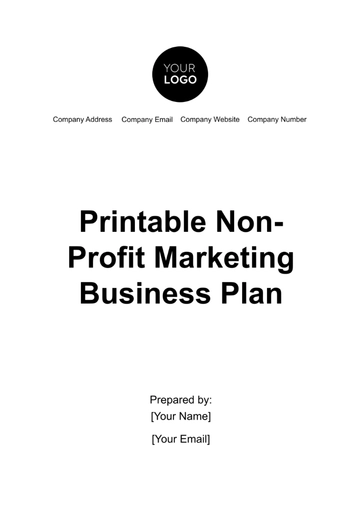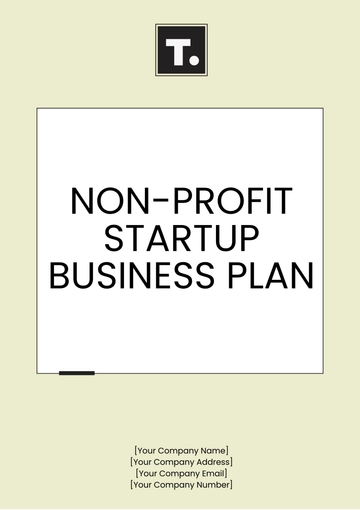Free Nonprofit Business Plan

I. Executive Summary
A. Mission Statement
Our mission is to empower underprivileged communities through education and sustainable development initiatives.
B. Vision Statement
We envision a world where every individual has equal access to opportunities for growth and prosperity.
C. Objectives
To provide quality education to 10,000 children in rural areas by 2055.
To establish 50 vocational training centers by 2060.
To implement sustainable agriculture projects benefiting 100,000 farmers by 2058.
D. Key Initiatives
Our key initiatives include building schools, providing vocational training, and promoting eco-friendly farming practices.

II. Organization Description
A. Organizational Structure
We operate as a non-profit organization with a hierarchical organizational structure comprising executive leadership, a board of directors, and operational staff.
B. Legal Structure
Our organization is registered as a 501(c)(3) nonprofit corporation under the laws of the [State].
C. History and Background
Founded in 2050 by visionary leaders, we have been serving communities in need for over a decade.
D. Key Personnel
Executive Director: [Your Name]
Board of Directors:
Mr. Michael Smith (Chairperson)
Ms. Sarah Lee
Dr. David Patel
Staff Members:
Program Managers, Educators, Outreach Coordinators
III. Market Analysis
A. Target Audience
Our target audience includes marginalized communities, children from low-income families, and small-scale farmers.
B. Competitive Analysis
Competitor 1: ABC Foundation
Competitor 2: XYZ Charity
Competitor 3: Global Aid Organization
C. Market Trends
Increasing demand for education in rural areas.
Growing awareness of sustainable development practices.
Shift towards community-based initiatives.
IV. Programs and Services
A. Program Description
School Building Program: Constructing and renovating schools in underserved areas.
Vocational Training Program: Offering skill development courses in trades such as carpentry, tailoring, and agriculture.
Farmer Support Program: Providing training and resources for sustainable farming practices.
B. Service Offerings
Education: Providing free education, school supplies, and scholarships.
Vocational Training: Offering free or subsidized vocational courses.
Farmer Support: Supplying seeds, tools, and training in organic farming techniques.
V. Marketing and Fundraising Strategy
A. Marketing Plan
Online Marketing Strategy: Leveraging social media campaigns and email newsletters to raise awareness.
Offline Marketing Strategy: Organizing community events, fundraisers, and awareness drives.
Social Media Strategy: Regularly update social media platforms with success stories and impact updates.
B. Fundraising Plan
Donor Acquisition Strategy: Engaging with corporate sponsors, individual donors, and grant-making foundations.
Grant Writing Strategy: Identifying and applying for grants from government agencies and philanthropic organizations.
Event Fundraising Strategy: Hosting annual galas, charity auctions, and benefit concerts to raise funds.
VI. Financial Plan
A. Budget Allocation
Allocation of funds:
Education Programs: 40%
Vocational Training: 30%
Sustainable Agriculture: 20%
Administrative Expenses: 10%
B. Revenue Streams
Grants and Donations
Corporate Sponsorships
Fundraising Events
C. Expense Projections
Expense Category | Annual Budget |
|---|---|
Administrative Expenses | $200,000 |
Program Expenses | $2,000,000 |
Fundraising Expenses | $300,000 |
VII. Implementation Plan
A. Timeline
School Building Program: 2050-2055
Vocational Training Centers: 2052-2060
Farmer Support Program: Ongoing from 2050
B. Resource Allocation
Human Resources: Recruitment of skilled educators, trainers, and project managers.
Financial Resources: Budget allocation for program implementation and operational expenses.
Material Resources: Procurement of construction materials, educational supplies, and agricultural inputs.
C. Monitoring and Evaluation
Regular monitoring of program outcomes and impact through surveys, assessments, and field visits.
Evaluation of key performance indicators to measure progress toward organizational goals.
VIII. Risk Management
A. Risk Assessment
Funding Uncertainty
Regulatory Compliance
Community Resistance
B. Mitigation Strategies
Diversification of Funding Sources
Compliance Monitoring and Reporting
Community Engagement and Stakeholder Consultation
IX. Conclusion
Our nonprofit is committed to impacting communities by providing education, skills training, and sustainable development solutions. Together, we can create a brighter future for generations to come.
X. Appendices
Appendix A: Detailed Budget Breakdown for Programs and Services
Appendix B: Case Studies and Success Stories
Appendix C: Program Evaluation Reports
Appendix D: Partnerships and Collaborations
Appendix E: Organizational Bylaws and Policies
- 100% Customizable, free editor
- Access 1 Million+ Templates, photo’s & graphics
- Download or share as a template
- Click and replace photos, graphics, text, backgrounds
- Resize, crop, AI write & more
- Access advanced editor
Crafted by the experts at Template.net, our Nonprofit Business Plan Template is your roadmap to success. Easily editable and fully customizable, this comprehensive template is tailored to suit your organization's unique needs. With seamless integration into our Ai Editor Tool, creating a professional business plan has never been easier. Unlock your nonprofit's potential today.
You may also like
- One Page Business Plan
- Coffee Shop Business Plan
- Restaurant Business Plan
- Food Business Plan
- Real Estate Business Plan
- Executive Summary Business Plan
- Cover Page Business Plan
- Nonprofit Business Plan
- Daycare Business Plan
- Construction Business Plan
- Startup Business Plan
- Medical Business Plan
- Bakery Business Plan
- Service Plan
- Hotel Business Plan
- Catering Business Plan
- School Business Plan
- Healthcare Business Plan
- Transportation Plan
- Sports Plan
- Car Wash Business Plan
- Salon Business Plan
- Clothing Business Plan
- Farming Business Plan
- Boutique Plan
